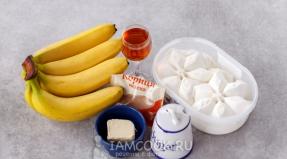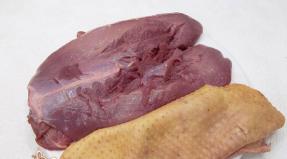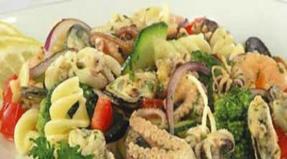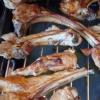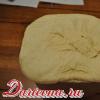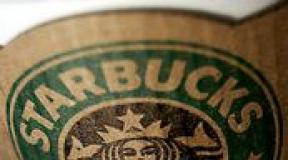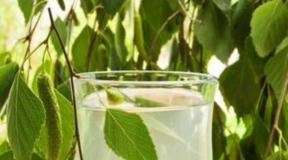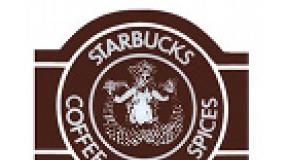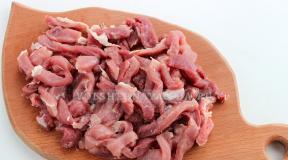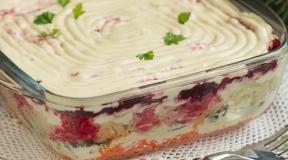Marking of canned pollock liver on a jar. Canned fish liver
The examination showed that manufacturers of popular canned fish have embarked on the path of correction and comply with GOSTs.
Canned food called “Cod Liver” has long ceased to be in short supply, as it was in Soviet times, but is still considered an attribute of the festive table. However, even one jar of cod liver can spoil the celebration and discourage any desire to continue to buy this product if, for example, the buyer found helminths in it. It was such a nuisance that happened to a Petersburger Galina S., which filed a complaint with the St. Petersburg public organization of consumers "Public Control" on the products of one of the Murmansk manufacturers. The consumer's signal became the basis for public quality control of ten brands of cod liver. The samples purchased in the shops of the city were sent for research to the Federal State Budgetary Institution "Leningrad Interregional Veterinary Laboratory".
Not the worms we eat
Gloomy folk wisdom says: "Not the worms that we eat, but what eats us." But when Galina S. opened a jar of Murmansk Delicacy cod liver, she was in no mood for jokes: in canned food she saw inanimate roundworms - helminths, which she had absolutely no desire to feast on. An appeal to the fish department of the store where the “delicacy” was purchased upset me even more. The seller refused to return the money, citing the fact that the regulations allow the presence of helminths in this product.
With the presence of helminths in the cod liver, "Public Control" encountered during the examination in 2011. Then unappetizing dead worms were found in three of the eight samples tested. Moreover, this fact did not become a reason for the rejection of canned food, since SanPiN allows the presence of dead helminths in them. It is believed that after heat treatment they are absolutely safe for human health.
- GOST does not allow the presence of foreign impurities in these canned food, but helminths, alas, are not foreign, and according to sanitary standards, they are inanimate, they are completely harmless, - confirms chief technologist of Giprorybflot JSC Evgenia Lobova.- Of course, from the point of view of the consumer, it is unpleasant to observe them in the bank, therefore, according to the technological instructions, visible helminths must be removed at the processing stage.
“Yes, as a consumer, I also had experience of detecting helminths in cod liver,” says Tatyana Vasilyeva, head of the laboratory of food microbiology and veterinary and sanitary examination of the Leningrad Interregional Veterinary Laboratory. “Fortunately, we did not find anything of the kind in the samples we examined.
Freeze or salt
Another way to make helminth-infested raw materials safe is to freeze them and keep them below -18°C. Moreover, GOST 13272-2009 allows the production of this type of canned food from both fresh and frozen raw materials. True, according to experts, such a delicate product as the liver, after freezing and long-term storage in the cold, loses both taste and usefulness.
– If you didn’t like the taste of canned food, there is a good chance that they are made from raw ice cream. Freezing certainly degrades the quality of cod liver, says Evgenia Lobova. - And for sure, some of its useful properties are lost. In addition, no one can guarantee that the temperature regimes were strictly observed during storage and transportation.
Canned cod liver products are inferior to those produced directly in the sea in other respects as well. In particular, to hide the defects of frozen raw materials, manufacturers often add more salt. For example, in canned food "Murmansk Cod Liver" TM "Master of the Baltic" (LLC "Dema", Murmansk) salt turned out to be 2.4% at the rate allowed by GOST: 1.2% - 2.5%. Perhaps the maximum amount of salt was used in order to stop the oxidation of stale raw materials.
“Salt is not only the most famous preservative, but also the easiest flavor enhancer,” says Tatyana Vasilyeva. - With its help, you can divert the attention of the consumer from some taste deficiencies in the product. Although the organoleptic characteristics of this sample correspond to the standards: without extraneous taste and smell.
"Natural" or "in Murmansk"?
However, there is another way to rid the cod liver of helminths. Its use even led to the emergence of a new type of canned food. Today, fans of the fish delicacy know that if “Natural Cod Liver” is written on the jar, then inside there are whole pieces of the liver. If “Murmansk-style cod liver” is indicated, then the jar contains a homogeneous finely ground mass. At the same time, many people mistakenly believe that “Murmansk-style liver” is worse in quality, since anything can be put into a finely ground mass.
Supplements are also found in natural liver. Thus, during an inspection in 2014, the laboratory of Giprorybflot JSC, which conducted research on the instructions of the Public Control, found milt instead of liver in canned food produced by Volna Severa LLC. It's nice that this time the products of this company passed the examination without comment.
According to Igor Grekov, Chief Technologist of Sagittarius JSC, canned "Murmansk Cod Liver" is not a way to save on the main raw materials, but, on the contrary, a high-quality product.
- Pieces - this is the last century! The main problem of cod liver producers is a large infestation with nematodes, says Igor Grekov. - There is only one way to completely get rid of them - mechanical processing at a technological installation that separates large vessels, films and, along with them, nematodes. In canned food "Natural Cod Liver" all this remains, including dead nematodes.
According to Evgenia Lobova, "Murmansk cod liver" is a relatively new product, but it quickly became popular with consumers.
– Today, “Murmansk Cod Liver” is produced by many enterprises, – says the expert. - The old GOST 13272-2009, which is still valid, allows various additives for its production - starch, flour, milk powder, spices. Therefore, in order to produce high-quality products, it was decided to develop a new GOST R 56418-2015, which singled out canned food “Murmansk Cod Liver”, produced at sea, into a separate group of products.”
New GOST for those at sea
The emergence of the new GOST was initiated by a group of fishing companies that produce their canned food from fresh raw materials directly in the sea.
“I think I won’t reveal a secret if I say that the quality of canned fish depends on the quality of raw materials, which directly depends on the shelf life,” says Igor Grekov. - Least of all raw materials are stored at sea on ships, and in fact, floating factories - there is simply no physical opportunity to keep the catch for a long time without processing. If canned food is made on the shore, then this means one thing: the raw materials, before getting to the factory, have come a long way, including mandatory freezing. There are few canning factories left in Murmansk, so part of the raw materials are sent to other cities, for example, to Moscow and St. Petersburg.” One of the risks for consumers is non-compliance with storage conditions during transportation and warehousing.
According to the new regulatory document, this type of canned food is allowed to be made only from fresh raw materials, while the label must indicate “Made at sea from fresh raw materials”. Moreover, GOST R 56418-2015 is strict to the composition of the product.
“Only cod liver and salt,” emphasizes Evgenia Lobova. - Canned food produced in accordance with this GOST is safe, since a scientifically based sterilization formula is used in their production. We also managed to clarify some characteristics of this product in the course of research - for example, in terms of increasing the shelf life. And already as a consumer, I will say: “Murmansk-style cod liver”, produced at sea, is much tastier than similar canned food produced on the shore.
In addition to organoleptic differences - taste, color, smell - there is a huge objective difference between sea and coastal canned food, - explains Igor Grekov. - This is the quality of the fat that is part of them. After all, it is not in vain that the new GOST R 56418-2015 introduced the "acid number" indicator, which characterizes the quality of the fat released from the raw materials during the sterilization of canned food. In canned food produced at sea, it corresponds in acid number to edible fat, and in "coastal" - only to veterinary or technical fat in general. The new GOST, adopted two years ago, finally brought canned seafood from Murmansk cod liver into the premium segment, separated it from the general “gray” mass of products produced on the coast.
You can buy!
It is gratifying that all ten tested samples of canned cod liver fish met the requirements of GOST. Among them are the products of JSC "Taurus" and JSC "Strelets", manufactured according to the new GOST R 56418 - 2015, as well as products manufactured according to the old GOST 13272-2009, manufacturers of JSC "Karat-1", LLC "Parus", LLC " Wave of the North, LLC Bosco Moreproduct, LLC Nord Sea Food, LLC Dema (all from Murmansk) and LLC Dalpromryba (Moscow region).
When choosing a fish delicacy, experts advise paying attention to the type of can and carefully reading the label.
– The jar must not be swollen or deformed. It is also important to pay attention to the standards by which the product is produced and what is included in its composition, - says Tatyana Vasilyeva. - Of course, a product made from fresh raw materials always attracts the consumer, but I would not say that the taste of canned cod liver is significantly different, unless, of course, the storage conditions of the raw materials were violated. And poor raw materials will certainly give out a bitter aftertaste, characteristic of fish products that have been stored for a long time and incorrectly.
By the way, nutritionists insist on the usefulness of cod liver. It is from it that the well-known fish oil is made. And in canned form, even 30–40 g of this product per day can make up for the lack of vitamins and help to cope with beriberi. Doctors especially recommend cod liver to children and expectant mothers.
Irina Golubenko
Word to the expert
Rostislav Shipitsyn, Director of the St. Petersburg State Budgetary Institution "Center for Quality Control of Goods (Products), Works and Services":
- When buying canned fish, including Cod Liver, you need to carefully look at the packaging. Mainly tin cans are used, which should be free from deformation, rust stains, and not swollen. Read the information on the packaging carefully and give preference to those that say "made from fresh liver" or "made at sea from fresh liver." It is better if the canned food was produced near the place where the cod was caught. For canned food of the 1st grade, frozen liver is most often used.
Having opened a jar of natural cod liver, we will see the liver whole or in pieces, color from beige to light brown or gray in various shades. D descends color heterogeneity in one liver bank, transparent fat, color from straw to yellow. There should be no foreign taste, slight bitterness is allowed for canned food made from frozen raw materials. The smell is characteristic of canned food of this type, without foreign smell.
“Murmansk Cod Liver” is different from “Natural Cod Liver”
appearance: is a finely ground mass.
It should be remembered that for all its usefulness (cod liver contains vitamins A, D, E, Omega-3 - polyunsaturated fatty acids), this is a high-calorie product, so it should be eaten in moderation.
During the implementation of the project “Say NO to counterfeit!” state support funds allocated as a grant in accordance with the Decree of the President of the Russian Federation of April 5, 2016 No. 68-rp and on the basis of a competition held by OOD "Civil Dignity" are used.
GOST 13272-2009
Group H23
INTERSTATE STANDARD
CANNED FISH LIVER
Specifications
Canned fish liver. Specifications
ISS 67.120.30
OKP 92 7123, 92 7129,
92 7131, 92 7139
Introduction date 2011-01-01*
_________________________
* See "Notes" label.
Foreword
The goals, basic principles and basic procedure for carrying out work on interstate standardization are established by GOST 1.0-92 "Interstate standardization system. Basic provisions" and GOST 1.2-2009 "Interstate standardization system. Interstate standards, rules and recommendations for interstate standardization. Rules for the development, adoption, application, renewal and cancellation
About the standard
1 DEVELOPED by the Open Joint Stock Company "Research and Design Institute for the Development and Operation of the Fleet" (JSC "Giprorybflot") and the Federal State Unitary Enterprise "Polar Research Institute of Marine Fisheries and Oceanography named after N.M. Knipovich" (FSUE "PINRO")
2 INTRODUCED by the Federal Agency for Technical Regulation and Metrology
3 ADOPTED by the Interstate Council for Standardization, Metrology and Certification (Minutes N 36 of November 11, 2009)
Voted to accept:
Short name of the country according to MK (ISO 3166) 004-97 | Abbreviated name of the national standards body |
|
Azerbaijan | Azstandard |
|
Armstandard |
||
Belarus | State Standard of the Republic of Belarus |
|
Gruzstandard |
||
Kazakhstan | State Standard of the Republic of Kazakhstan |
|
Kyrgyzstan | Kyrgyzstandart |
|
Moldova-Standard |
||
the Russian Federation | Rosstandart |
|
Tajikistan | Tajikstandart |
|
Turkmenistan | Main State Service "Turkmenstandartlary" |
|
Uzbekistan | Uzstandard |
|
Gospotrebstandart of Ukraine |
4 By order of the Federal Agency for Technical Regulation and Metrology of October 15, 2010 N 308-st GOST 13272-2009 was put into effect as a national standard of the Russian Federation from January 1, 2011.
5 INSTEAD OF GOST 13272-80
Information on the entry into force (termination) of this standard is published in the index "National Standards".
Information about changes to this standard is published in the "National Standards" index, and the text of the changes is published in the "National Standards" information indexes. In case of revision or cancellation of this standard, the relevant information will be published in the information index "National Standards"
INTRODUCED Amendment N 1, adopted by the Interstate Council for Standardization, Metrology and Certification (minutes N 40-2011 dated November 29, 2011). State-developer Russia. By order of Rosstandart dated April 17, 2012 N 37-st, it was put into effect on the territory of the Russian Federation from July 1, 2012
Change N 1 was made by the database manufacturer according to the text of IUS N 7, 2012
1 area of use
1 area of use
This standard applies to canned food made from the liver of macrourid, hake, notothenia, cod, salmon Pacific fish natural or in tomato sauce and canned liver (hereinafter referred to as canned food).
2 Normative references
This standard uses normative references to the following interstate standards:
GOST 21-94 Sugar-sand. Specifications
GOST 22-94 Refined sugar. Specifications*
______________
GOST R 53396-2009 "White sugar. Specifications".
GOST 1128-75 Refined cottonseed oil. Specifications
GOST 1129-93 Sunflower oil. Specifications*
_______________
* On the territory of the Russian Federation, GOST R 52465-2005 "Sunflower oil. Specifications" is valid.
GOST 1723-86 Fresh onion harvested and supplied. Specifications
GOST 2874-82 Drinking water. Hygiene requirements and quality control*
_______________
* On the territory of the Russian Federation, GOST R 51232-98 "Drinking water. General requirements for the organization and methods of quality control" is in force.
GOST 3343-89 Concentrated tomato products. General specifications
GOST 4495-87 Whole milk powder. Specifications*
________________
* On the territory of the Russian Federation, GOST R 52791-2007 "Canned milk. Powdered milk. Specifications", GOST R 53946-2010 "Canned milk. Powdered milk for the production of baby food. Specifications" are in force.
GOST 5981-88 Metal cans for canned food. Specifications
GOST 7587-71 Dried onion. Specifications*
_________________
* On the territory of the Russian Federation, GOST R 52622-2006 "Dried vegetables. General technical conditions" is in force.
GOST 7825-96 Soybean oil. Specifications*
________________
* On the territory of the Russian Federation, GOST R 53510-2009 "Soybean oil. Specifications" is in force.
GOST 7981-68 Peanut oil. Specifications
GOST 8756.0-70 Canned food products. Sampling and preparing them for testing
GOST 8756.18-70 Canned food products. Methods for determining the appearance, tightness of containers and the condition of the inner surface of metal containers
GOST 8807-94 Mustard oil. Specifications
GOST 8808-2000 Corn oil. Specifications
GOST 10444.1-84 Canned food. Preparation of solutions of reagents, dyes, indicators and nutrient media used in microbiological analysis
GOST 10444.2-94 Food products. Methods for detecting and quantifying Staphylococcus*
_______________
* On the territory of the Russian Federation, GOST R 52815-2007 "Food products. Methods for detecting and determining the number of coagulase-positive staphylocci and Staphylococcus aureus" is in force.
GOST 10444.7-86 Food products. Methods for the detection of botulinum toxins and Clostridium botulinum
GOST 10444.8-88 Food products. Method for determination of Bacillus cereus
GOST 10444.9-88 Food products. Method for determination of Clostridium perfringens
GOST 10444.11-89 Food products. Methods for determining lactic acid microorganisms
GOST 10444.12-88 Food products. Method for the determination of yeasts and molds
GOST 10444.15-94 Food products. Methods for determining the number of mesophilic aerobic and facultative anaerobic microorganisms
GOST 10970-87 Skimmed milk powder. Specifications*
_________________
* On the territory of the Russian Federation, GOST R 52791-2007 "Canned milk. Powdered milk. Specifications" is in force.
GOST 11771-93 Canned fish and seafood products. Packaging and labeling
GOST 13830-97 Edible table salt. General specifications*
_______________
* On the territory of the Russian Federation, GOST R 51574-2000 "Edible table salt. Specifications" is in force.
GOST 14192-96 Marking of goods
GOST 15846-2002 Products shipped to the Far North and equivalent areas. Packaging, marking, transportation and storage
GOST 17594-81 Dry bay leaf. Specifications
GOST 23285-78 Transport bags for foodstuffs and glass containers. Specifications
GOST 24597-81 Packages of packaged goods. Main parameters and dimensions
GOST 26574-85 Baking wheat flour. Specifications*
_______________
* On the territory of the Russian Federation, GOST R 52189-2003 "Wheat flour. General specifications" is in force.
GOST 26663-85 Transport packages. Formation using packaging tools. General technical requirements
GOST 26664-85 Canned fish and seafood products. Methods for determining organoleptic indicators, net weight and mass fraction of constituents
GOST 26668-85 Food and flavor products. Sampling methods for microbiological analyzes*
_________________
* GOST R 54004-2010 "Food products. Sampling methods for microbiological tests" is in force on the territory of the Russian Federation.
GOST 26669-85 Food and flavor products. Sample preparation for microbiological analysis
GOST 26670-91 Food products. Methods for cultivating microorganisms
GOST 26808-86 Canned fish and seafood. Methods for determination of solids
GOST 26927-86 Food raw materials and products. Methods for the determination of mercury
GOST 26929-94 Food raw materials and products. Sample preparation. Mineralization to determine the content of toxic elements
GOST 26932-86 Food raw materials and products. Lead determination methods
GOST 26933-86 Food raw materials and products. Methods for the determination of cadmium
GOST 26935-86 Canned food products. Tin determination method
GOST 27082-89 Canned fish and seafood products. Methods for determining total acidity
GOST 27207-87 Canned fish and seafood products. Method for determining table salt
GOST 29045-91 Spices. Fragrant pepper. Specifications
GOST 29047-91 Spices. Carnation. Specifications
GOST 29050-91 Spices. Pepper black and white. Specifications
GOST 29055-91 Spices. Coriander. Specifications
GOST 30178-96 Food raw materials and products. Atomic absorption method for the determination of toxic elements
GOST 30425-97 Canned food. Method for determining industrial sterility
GOST 30538-97 Food products. Method for determining toxic elements by atomic emission method
Note - When using this standard, it is advisable to check the validity of the reference standards according to the "National Standards" index, compiled as of January 1 of the current year, and according to the corresponding information indexes published in the current year. If the reference standard is replaced (modified), then when using this standard, you should be guided by the replacing (modified) standard. If the referenced standard is canceled without replacement, the provision in which the reference to it is given applies to the extent that this reference is not affected.
(Changed edition, Rev. N 1).
3 Classification
3.1 The name and assortment signs of canned food are indicated in Table 1.
Table 1
Name of canned food | Assortment sign |
Natural grenadier liver | |
Pollock liver in tomato sauce | |
Pollock liver "Far East" | |
Natural pollock liver | |
Seaside Pollack Liver | |
Burbot liver in tomato sauce | |
Natural burbot liver | |
Notothenia liver natural | |
Polar cod liver in tomato sauce | |
Polar cod liver natural | |
Blue whiting liver natural | |
Pacific salmon liver in tomato sauce | |
Cod liver in tomato sauce | |
Natural cod liver | |
Murmansk cod liver | |
Seaside cod liver | |
Natural hake liver |
3.2 It is allowed to produce another range of canned food that meets the requirements of this standard, if there is an assortment sign and using the raw materials and materials provided for by the standard.
4 Technical requirements
4.1 Canned food must be manufactured in accordance with the requirements of this standard according to the technological instructions in compliance with the sanitary norms and rules approved in the prescribed manner.
4.2 Characteristics
4.2.1 Fish livers must be packed in jars with or without the addition of tomato sauce or food ingredients; chopped fish liver should be mixed with the ingredients and placed in jars.
4.2.2 Cans with the product must be hermetically sealed and sterilized at temperatures above 100 °C.
4.2.3 In terms of safety, canned food must comply with sanitary rules, norms and hygienic standards or technical regulations in force in the territory of the state that adopted the standard.
4.2.4 In terms of chemical and physical indicators, canned food must comply with the standards specified in Table 2.
table 2
Name of indicator | Test method |
|
Mass fraction of table salt, %, for canned food: | ||
natural | ||
in tomato sauce | ||
From shredded liver | ||
Total acidity (in terms of malic acid) for canned food in tomato sauce,% | ||
Mass fraction of components for canned food in tomato sauce, %, not less than: | ||
Liver | ||
tomato sauce | ||
Mass fraction of solids for canned food in tomato sauce, %, not less than |
4.2.5 In terms of organoleptic characteristics, canned food must comply with the requirements specified in Table 3.
Table 3
Name of indicator | Characteristic |
Peculiar to canned food of this type, without extraneous aftertaste. |
|
May be: |
|
Weak taste of iodine; |
|
Weak bitterness for canned food made from frozen raw materials |
|
Peculiar to canned food of this type, without foreign smell. With a slight aroma of spices - for preserves made with spices |
|
Liver consistency | Tender, juicy. |
Can be dense for notothenic fish species and for canned food made from frozen raw materials |
|
Canned liver condition: | |
Natural and in tomato sauce | Whole or in pieces. |
From shredded liver | Finely ground mass |
From beige to light brown or gray in various shades. |
|
There may be color inhomogeneity in one bank |
|
Released fat | Straw to yellow. |
May be: |
|
Greenish for canned food made from the liver of macrourid fish species; Light orange for canned food made from ice cream raw materials. |
|
tomato sauce | From orange to red. |
Orange to red-brown for preserves made from frozen Pacific salmon liver. |
|
The released broth | From light brown to brown in various shades for canned food made from the liver of notothenic fish species and pollock |
Presence of foreign matter | Not allowed |
4.3 Requirements for raw materials and materials
4.3.1 Raw materials used for the manufacture of canned food are not lower than the first grade (if grades are available) and correspond to:
- fish liver raw, chilled, frozen - to regulatory documents;
- edible salt - GOST 13830;
- fresh onion - GOST 1723;
- dried onion - GOST 7587;
- quick-frozen chopped onion - to regulatory documents;
- baking wheat flour - GOST 26574;
- granulated sugar -
GOST 13830-97
5. The validity period was removed according to protocol N 5-94 of the Interstate Council for Standardization, Metrology and Certification (IUS 11-12-94)
6. EDITION (November 2008) with Amendments Nos. 1, 2, 3, 4, 5 approved in December 1980, January 1985, January 1986, December 1989, October 1991 (IUS 2-81, 4-85, 5-86, 2-90, 1-92)
This standard establishes requirements for natural canned food and in tomato sauce made from the liver of cod, macrourid and notothenia fish, as well as for canned food in tomato sauce made from the liver of Pacific salmon fish, produced for the needs of the national economy and export.
OKP codes for canned fish are given in the Appendix.
(Changed edition, Rev. N 1, 4).
1. TECHNICAL REQUIREMENTS
1. TECHNICAL REQUIREMENTS
1.1. Canned food must be produced in accordance with the requirements of this standard for technological instructions in compliance with sanitary standards and rules approved in the prescribed manner.
(Changed edition, Rev. N 4).
1.2. The liver must be placed in jars with or without filling with tomato sauce, chopped liver must be mixed with the components, hermetically sealed and sterilized at a temperature above 100 °C.
1.2a. By quality, canned food is divided into export and for the needs of the national economy.
Canned food produced for the needs of the national economy is divided into two grades according to quality: the highest and the first.
1.3. Raw materials used for the manufacture of canned food must be at least the first grade (if grades are available) and meet the requirements of:
raw liver - normative and technical documentation;
chilled liver - normative and technical documentation;
frozen liver - normative and technical documentation;
raw fish - normative and technical documentation;
frozen food waste of the Far Eastern salmon fish - of normative and technical documentation;
edible salt - GOST 13830*;
________________
GOST R 51574-2000.
fresh onion - GOST 1723 ;
dried onion - GOST 7587 *;
_______________
* On the territory of the Russian Federation is valid GOST R 52622-2006.
fried mashed onion - normative and technical documentation;
wheat flour for baking GOST 26574 *;
_______________
* On the territory of the Russian Federation, in addition to packaging, labeling, transportation and storage, there are GOST R 52189-2003 and GOST 26791-89.
granulated sugar - GOST 21 ;
rafinated sugar - GOST 22 *;
refined sunflower oil GOST 1129 *;
_______________
* On the territory of the Russian Federation is valid GOST R 52465-2005(here and below).
refined cottonseed oil GOST 1128 ;
refined soybean oil GOST 7825 ;
refined peanut butter - GOST 7981 ;
refined mustard oil GOST 8807 ;
refined corn oil GOST 8808 ;
olive oil;
tomato puree and tomato paste GOST 3343 ;
acetic acid food - GOST 6968 , GOST 61 and other regulatory and technical documentation;
drinking water - GOST 2874 *;
________________
* On the territory of the Russian Federation is valid GOST R 51232-98.
bay leaf - GOST 17594 ;
coriander - regulatory and technical documentation;
black pepper - regulatory and technical documentation;
allspice - normative and technical documentation;
carnation - regulatory and technical documentation;
spice extracts - regulatory and technical documentation.
It is allowed to use:
pollock liver with a mass fraction of fat 30-40%;
hydrated and unrefined sunflower oil of the highest grade - GOST 1129 ;
wheat flour of the second grade;
dry skimmed cow's milk GOST 10970 *;
________________
* On the territory of the Russian Federation is valid GOST R 52791-2007.
whole milk powder - GOST 4495 *.
________________
* On the territory of the Russian Federation, except for the part relating to powdered milk for the production of baby food, there is GOST R 52791-2007.
Canned food of the highest grade is made from raw or chilled liver.
(Changed edition, Rev. N 4, 5).
1.4. Canned food must meet the requirements of industrial sterility and do not contain pathogenic organisms or their toxins.
(Changed edition, Rev. N 5).
1.5. In terms of chemical and physical indicators, canned food must comply with the requirements and standards specified in Table 1.
Table 1
Name of indicator | Test method |
|
Mass fraction of table salt, %: | ||
for natural preserves | 1.5 to 2.5 | |
for preserves in tomato sauce and for preserves "Murmansk Cod Liver", "Pollock Liver "Far East" | 1.2 to 2.0 | |
Acidity (in terms of malic acid) for canned food in tomato sauce,% | 0.3 to 0.6 | |
Mass fraction of components (for canned food in tomato sauce), %, not less than: | ||
liver | ||
tomato sauce |
(Changed edition, Rev. N 4, 5).
1.5a. The content of toxic elements and pesticides in canned fish liver should not exceed the permissible levels established in the biomedical requirements and sanitary standards for the quality of food raw materials and foodstuffs of the Ministry of Health of the USSR N 5061, approved on 19.08.89.*
________________
* On the territory of the Russian Federation there are SanPiN 2.3.2.1078-2001.
(Changed edition, Rev. N 5).
1.6. According to organoleptic indicators, canned food must meet the requirements specified in Table 2.
table 2
Name of indicator | Characteristics of canned food |
||
made for export | made for the needs of the national economy |
||
premium | first class |
||
Pleasant, characteristic of canned food of this type. A slight taste of iodine is allowed |
|||
Pleasant, characteristic of canned food of this type. For canned food made with the use of spices - with a slight aroma of the constituent components |
|||
Allowed for crushed pollock liver - without the aroma of spices |
|||
Consistency | Juicy, tender |
||
For the liver of notothenic fish, compacted |
|||
Main product status | Whole or in pieces |
||
Pollack and cod liver can be crushed |
|||
for canned goods: | |||
"Murmansk cod liver" | Finely ground mass |
||
Creamy to grayish | |||
liver | For haddock liver, pollock can be gray in different shades. For the liver of notothenia fish, it can be from beige to light brown, for the frozen liver of Pacific salmon fish, from light brown to light gray |
||
Uneven liver color is allowed in one jar |
|||
tomato sauce | orange to red |
||
For frozen Pacific salmon liver orange to brown red |
|||
released fat | For cod fish liver from straw to yellow |
||
For the liver of macrourid fish, it may be greenish |
|||
Canned with tomato sauce - orange |
|||
broth: | |||
for the liver of notothenian fish | Light brown in various shades |
||
for pollock liver | Brown in various shades |
||
Presence of foreign matter | Not allowed |
||
Note. It is allowed for the first grade in canned pollock liver with a mass fraction of fat of 30-40%, the presence of broth.
(Changed edition, Rev. N 4, 5).
1.7. Requirements for quality, packaging and labeling may be changed in accordance with the requirements of the agreement (contract) of the enterprise with a foreign economic organization or a contract with a foreign buyer.
(Changed edition, Rev. N 5).
2. ACCEPTANCE RULES
2.1. Acceptance rules - according to GOST 8756.0.
2.2. Control of the content of toxic elements and pesticides is carried out in accordance with the procedure established by the manufacturer of products in agreement with the state sanitary supervision and guaranteeing the safety of products.
(Changed edition, Rev. N 5).
2.3. Microbiological quality control of canned food is carried out in accordance with instructions on the procedure for sanitary and technical control of canned food at manufacturing enterprises, wholesale depots, retail trade and catering establishments N 1121, approved 18.09.73.
4.1. Packing and labeling canned food GOST 11771.
4.2. Canned food is packed in metal cans with a capacity of not more than 353 cm GOST 5981.
The inner surface of jars and lids must be varnished or enamelled.
4.3. Canned food is transported by transport of all types in accordance with the rules for the carriage of goods in force for this type of transport.
Packing - by GOST 23285.
Basic parameters and sizes of packages - according to GOST 24597.
4.4. Canned food is stored in clean, well-ventilated rooms at a temperature of 0 to 15 °C and a relative humidity of no more than 75%.
Shelf life of canned food from the date of manufacture:
for natural:
1.5 years - from the raw liver of Pacific salmon fish;
2.5 years - from cod and pollock liver in whole cans;
2 years - for all other types of canned food;
1 year - for canned food in tomato sauce.
Sections 2-4. (Changed edition, Rev. N 4).
APPENDIX (reference). CODES FOR THE ALL-UNION CLASSIFIER
APPENDIX
Reference
Assortment of canned food | OKP code |
Cod liver (including small) natural | 92 7131 0010 |
Natural pollock liver | 92 7139 0240 |
Seaside Pollack Liver | 92 7139 1450 |
Natural grenadier liver | 92 7139 0250 |
Natural burbot liver | 92 7139 0280 |
Polar cod liver natural | 92 7139 0290 |
Blue whiting liver natural | 92 7139 0300 |
Cod liver (including small) in tomato sauce | 92 7123 0010 |
Burbot liver in tomato sauce | 92 7129 0460 |
Pollock liver in tomato sauce | 92 7129 1400 |
Notothenia liver natural | 92 7139 0260 |
Natural hake liver | 92 7139 0210 |
Far Eastern salmon liver in tomato sauce | 92 7129 1420 |
Polar cod liver in tomato sauce | 92 7129 1430 |
Murmansk cod liver | 92 7131 0020 |
Seaside cod liver | 92 7139 1660 |
Pollock liver "Far East" | 92 7139 1680 |
APPENDIX. (Changed edition, Rev. N 5).
Electronic text of the document
prepared by CJSC "Kodeks" and checked against:
official publication
Fish and fish products.
Canned and preserved fish, marinades and concentrates.
Specifications: Sat. GOSTs. Part 1. -
M.: Standartinform, 2008
National standard of the Russian Federation GOST R 56418-2015
"CANNEED FROM LIVER, CAVIAR AND MILK OF FISH "PO-MURMANSKI". SPECIFICATIONS"
(approved by order of the Federal Agency for Technical Regulation and Metrology dated May 29, 2015 N 517-st)
Canned fish liver, roe and milt "In the Murmansk style". Specifications
Introduced for the first time
Foreword
1 Developed by the Joint Stock Company "Scientific Research and Design Institute for the Development and Operation of the Fleet" (JSC "Giprorybflot") and the Federal State Budgetary Scientific Institution "Polar Research Institute of Marine Fisheries and Oceanography named after N.M. Knipovich" (FGBNU "PINRO")
2 Introduced by the Technical Committee for Standardization TC 299 "Canned and preserves from fish and non-fish objects, containers, control methods"
3 Approved and put into effect by order of the Federal Agency for Technical Regulation and Metrology dated May 29, 2015 N 517-st
4 First introduced
1 area of use
This standard applies to canned food from fresh liver, caviar and milk of fish "in Murmansk", made only in marine conditions (hereinafter referred to as canned food).
The species composition of fish used for the manufacture of canned food is given in Appendix A.
2 Normative references
This standard uses normative references to the following standards:
GOST 5981-2011 Metal cans and lids for them for canned food. Specifications
GOST ISO 7218-2011 Microbiology of food and animal feed. General requirements and recommendations for microbiological studies
GOST 8756.0-70 Canned food products. Sampling and preparing them for testing
GOST 8756.18-70 Canned food products. Method for determining the appearance, tightness of containers and the state of the inner surface of metal containers
GOST 10444.1-84 Canned food. Preparation of solutions of reagents, dyes, indicators and nutrient media used in microbiological analysis
GOST 10444.7-86 Food products. Methods for the detection of botulinum toxins and Clostridium botulinum
GOST 10444.8-2013 (ISO 7932:2004) Microbiology of food and animal feed. Horizontal method for enumeration of presumptive bacteria Bacillus cereus. Colony count method at 30°C
GOST 10444.9-88 Food products. Method for determination of Clostridium perfringens
GOST 10444.11-2013 Microbiology of food products and animal feed. Methods for detecting and counting the number of mesophilic lactic acid microorganisms
GOST 10444.12-2013 Microbiology of food and animal feed. Methods for detection and enumeration of yeasts and molds
GOST 10444.15-94 Food products. Methods for determining the number of mesophilic aerobic and facultative anaerobic microorganisms
GOST ISO/TS 11133-1-2014 Microbiology of food and animal feed. Guidelines for the preparation and production of culture media. Part 1: General guidelines for quality assurance of culture media preparation in the laboratory
GOST 11771-93 Canned fish and seafood products. Packaging and labeling
GOST 14192-96 Marking of goods
GOST 15846-2002 Products shipped to the Far North and equivalent areas. Packaging, marking, transportation and storage
GOST 23285-78 Transport bags for foodstuffs and glass containers. Specifications
GOST 24597-81 Packages of packaged goods. Main parameters and dimensions
GOST 26663-85 Transport packages. Formation using packaging tools. General technical requirements
GOST 26664-85 Canned fish and seafood products. Methods for determining organoleptic indicators, net weight and mass fraction of constituents
GOST 26669-85 Food and flavor products. Sample preparation for microbiological analysis
GOST 26670-91 Food products. Methods for cultivating microorganisms
GOST 26927-86 Food raw materials and products. Methods for the determination of mercury
GOST 26929-94 Food raw materials and products. Sample preparation. Mineralization to determine the content of toxic elements
GOST 26930-86 Food raw materials and products. Arsenic determination method
GOST 26932-86 Food raw materials and products. Lead determination methods
GOST 26933-86 Food raw materials and products. Methods for the determination of cadmium
GOST 26935-2003 Canned food products. Tin determination method
GOST 27207-87 Canned fish and seafood products. Method for determining table salt
GOST 28805-90 Food products. Methods for identifying and determining the amount of osmotolerant yeasts and molds
GOST 30054-2003 Canned fish and seafood preserves. Terms and Definitions
GOST 30178-96 Food raw materials and products. Atomic absorption method for the determination of toxic elements
GOST 30425-97 Canned food. Method for determining industrial sterility
GOST 30538-97 Food products. Method for determining toxic elements by atomic emission method
GOST 31628-2012 Food products and food raw materials. Stripping voltammetric method for determining the mass concentration of arsenic
GOST 31659-2012 (ISO 6579:2002) Food products. Method for detection of bacteria of the genus Salmonella
GOST 31744-2012 (ISO 7937:2004) Microbiology of food and animal feed. Clostridium perfringens colony count method
GOST 31746-2012 (ISO 6888-1:1999, ISO 6888-2:1999, ISO 6888-3:2003) Food products. Methods for detection and quantification of coagulase-positive staphylococci and Staphylococcus aureus
GOST 31747-2012 (ISO 4831:2006, ISO 4832:2006) Food products. Methods for detecting and determining the number of bacteria of the group of intestinal daddies (coliform bacteria)
GOST 31792-2012 Fish, marine mammals, marine invertebrates and products of their processing. Determination of the content of dioxins and dioxin-like polychlorinated biphenyls by chromato-mass spectral method
GOST 31904-2012 Food products. Sampling methods for microbiological testing
GOST 31983-2012 Food products, feed, food raw materials. Methods for determining the content of polychlorinated biphenyls
GOST 32130-2013 Glass jars for food products of the fishing industry. Specifications
GOST 32161-2013 Food products. Method for determining the content of cesium Cs-137
GOST 32163-2013 Food products. Method for determining the content of strontium Sr-90
GOST 32164-2013 Food products. Sampling method for the determination of strontium Sr-90 and cesium Cs-137
GOST R 50380-2005 Fish, non-fish objects and products from them. Terms and Definitions
GOST R 51074-2003 Food products. Information for the consumer. General requirements
GOST R 51232-98 Drinking water. General requirements for the organization and methods of quality control
GOST R 51301-99 Food products and food raw materials. Stripping voltammetric methods for determining the content of toxic elements (cadmium, lead, copper and zinc)
GOST R 51574-2000 Edible table salt. Specifications
GOST R 51766-2001 Food raw materials and products. Atomic absorption method for the determination of arsenic
GOST R 54463-2011 Containers made of cardboard and combined materials for food products. Specifications
Note - When using this standard, it is advisable to check the validity of reference standards, in the public information system - on the official website of the Federal Agency for Technical Regulation and Metrology on the Internet or according to the annual information index "National Standards", which was published as of January 1 of the current year , and according to the issues of the monthly information index "National Standards" for the current year. If an undated referenced reference standard has been replaced, it is recommended that the current version of that standard be used, taking into account any changes made to that version. If the reference standard to which the dated reference is given is replaced, then it is recommended to use the version of this standard with the year of approval (acceptance) indicated above. If, after the adoption of this standard, a change is made to the referenced standard to which a dated reference is given, affecting the provision to which the reference is given, then this provision is recommended to be applied without taking into account this change. If the reference standard is canceled without replacement, then the provision in which the reference to it is given is recommended to be applied in the part that does not affect this reference.
3 Terms and definitions
This standard uses the terms according to GOST R 50380, GOST 30054, as well as the following terms with the corresponding definitions:
3.1 cod roe [hadock] - raw (fresh) (raw (fresh) cod roe): Cod roe [hadock] of the third - fourth stage of maturity in ovaries, obtained from raw fish.
3.2 cod liver and milt - raw (fresh) (fresh) cod liver and milt cod liver and milt obtained from raw fish.
3.3 Canned fish liver, roe and milt "in the Murmansk style" canned fish liver, roe and milt "in the Murmansk style" made in marine conditions.
Note - The technology of canned food provides for preliminary cleaning of the liver, caviar and milk of fish, their grinding and the simultaneous removal of all nematodes, films and blood vessels.
4 Classification
4.1 The range of canned food produced according to this standard:
Cod liver "Murmansk";
Haddock liver "In Murmansk";
Assorted caviar and cod liver "Murmansk";
Assorted caviar and haddock liver "Murmansk";
Assorted caviar and cod milk "According to Murmansk";
Assorted caviar and haddock milk "According to Murmansk".
4.2 It is allowed to produce canned food of other names using the raw materials provided for by the standard and meeting the requirements of this standard, established by the regulatory legal acts of the Russian Federation*.
5 Technical requirements
5.1 Canned food must comply with the requirements of this standard and be manufactured according to technological instructions in compliance with the requirements established by the regulatory legal acts of the Russian Federation *.
5.2 Characteristics
5.2.1 Pre-cleaned and crushed fresh raw materials should be mixed with the addition of table salt, placed in jars, hermetically sealed and sterilized.
5.2.2 In terms of organoleptic and chemical parameters, canned food must comply with the requirements specified in Table 1.
Table 1
|
Name of indicator |
Characteristic and norm |
|
Peculiar to canned food of this type, without extraneous aftertaste. A slight aftertaste of bitterness is allowed, characteristic of haddock liver, not associated with fat oxidation. |
|
|
Peculiar to canned food of this type, without foreign smell |
|
|
The consistency of canned food from: Caviar and liver Caviar and milk |
Tender, juicy, chewy Dense or compacted, dryish Soft, spreadable or dense, dryish |
|
State: Liver, caviar and milk Released fat |
Finely ground. homogeneous mass. In canned food with caviar - the presence of eggs in the mass. Allowed: The presence of a small amount of released broth; Baking the mass to the lid or bottom of the jar; Presence of air bubbles Transparent |
|
canned color: From the liver From caviar and liver From caviar and milk Excreted fish oil (if any) |
Homogeneous. Pale pink to beige with a grayish tint Light beige to beige with a pinkish or grayish tint Beige in various shades Light straw to straw |
|
Laying order |
The mass is packed tightly. Uneven filling of the jar with the product is allowed |
|
Presence of foreign matter |
Not allowed |
|
Mass fraction of table salt, % | |
|
Acid number for canned food "Murmansk-style cod liver", "Murmansk-style haddock liver", mg KOH/g, not more than |
5.3 Requirements for raw materials
5.3.1 Raw materials used for the manufacture of canned food must be not lower than the first grade (if grades are available) and comply with:
Raw fish liver (fresh) - to regulatory documents;
Raw fish caviar (fresh) - to regulatory documents.
It is allowed to add saithe caviar to cod or haddock roe;
Raw fish milt (fresh) - to regulatory documents;
Edible salt - GOST R 51574;
Drinking water - GOST R 51232;
Pure sea water -.
Raw fish (fresh), during the cutting of which liver, caviar and milk are collected, must comply with the requirements of regulatory documents and be not lower than the first grade (if there are varieties).
5.3.2 The raw materials used for the manufacture of canned food, in terms of safety indicators, must comply with the requirements established by,.
5.4 Marking
5.4.1 Mark canned food in accordance with the requirements, GOST R 51074, GOST 11771.
Additionally, consumer packaging is marked with the inscription: "Made at sea from fresh raw materials."
5.4.2 Transport marking - according to, GOST 11771 and GOST 14192.
5.5 Packaging
5.5.1 Canned food is packed in accordance with GOST 11771 and released in jars:
Metal prefabricated or seamless in accordance with GOST 5981 or cans with an easy-to-open lid according to regulatory documents;
Glass according to GOST 5717.1, GOST 5717.2, GOST 32130 or according to regulatory documents.
The capacity of the cans should not exceed 353 cm3.
It is allowed to use cans of imported production of the specified capacity.
5.5.2 The limits of permissible negative and positive deviations of the net weight of the contents of the can from the nominal value must comply with the requirements of GOST 11771.
5.5.3 Canned food is packed in corrugated cardboard boxes in accordance with GOST R 54463.
Pre-canned food can be placed in a group (souvenir) package.
5.5.4 Each unit of transport packaging must contain canned food of the same name, in cans of the same type and one capacity, one date of manufacture.
5.5.5 Packaging and packaging materials must comply with the requirements, be clean, dry, free of foreign odors and made of materials approved for contact with food products and ensuring the safety and quality of canned food during transportation and storage.
The inner surface of metal cans and lids must be coated with varnish or enamel, or a mixture thereof, or other materials approved for food contact.
6 Acceptance rules
6.1 Acceptance rules - according to GOST 8756.0.
6.2 Control of the content of toxic elements, polychlorinated biphenyls, pesticides and radionuclides is carried out at intervals specified in the production control program.
6.3 The frequency of microbiological control of canned food is established by the manufacturer of products in accordance with.
6.4 The frequency of determining the indicators "Mass fraction of table salt", "Acid number" and "Presence of foreign impurities", as well as the net weight, is set by the manufacturer in the production control program.
7 Control methods
7.1 Sampling methods - according to GOST 8756.0, GOST 31904, GOST 32164 and.
Sample preparation for determination:
Organoleptic and chemical indicators - according to GOST 8756.0, GOST 26664;
Toxic elements - according to GOST 26929;
Microbiological indicators - according to GOST 26669 and.
Cultivation of microorganisms - according to GOST 26670, preparation of solutions, reagents, paints, indicators and nutrient media for microbiological analyzes - according to GOST ISO 7218, GOST 10444.1, GOST ISO / TS 11133-1 and.
7.2 Determination of organoleptic indicators - according to GOST 26664.
7.3 Determination of the appearance of the package, tightness and condition of the inner surface of metal cans - according to GOST 8756.18.
7.4 Determination of physical and chemical parameters:
Mass fraction of table salt - according to GOST 27207;
Acid number - by;
Net weights - according to GOST 26664.
7.5 Determination of microbiological indicators:
Industrial sterility - according to GOST 30425;
Bacteria of the group of Escherichia coli (coliforms) - according to GOST 31747;
Mesophilic lactic acid microorganisms - according to GOST 10444.11;
Yeast and mold fungi - according to GOST 10444.12, GOST 28805;
The number of mesophilic aerobic and facultative anaerobic microorganisms - according to GOST 10444.15;
Staphylococcus aureus - according to GOST 31746;
Salmonella - according to GOST 31659;
Botulinum toxins and Clostridium botulinum - according to GOST 10444.7;
Bacillus cereus - according to GOST 10444.8;
Clostridium perfringens - according to GOST 10444.9, GOST 31744;
7.6 Determination of toxic elements:
Lead - according to GOST R 51301, GOST 26932, GOST 30178, GOST 30538, GOST 31262,;
Arsenic - according to GOST R 51766, GOST 26930, GOST 30538, GOST 31262, GOST 31628,;
Cadmium - according to GOST R 51301, GOST 26933, GOST 30178, GOST 30538, GOST 31262,;
Mercury - according to GOST 26927;
Tin - according to GOST 26935;
Chrome - by .
7.7 Determination of radionuclides - according to GOST 32161, GOST 32163.
7.8 Determination of polychlorinated biphenyls - according to GOST 31983 and.
7.9 Determination of pesticides - by , .
7.10 Determination of dioxins - according to GOST 31792.
8 Transport and storage
8.1 Transport
8.1.1 Canned food is transported by all means of transport in accordance with the rules for the carriage of goods in force for this type of transport, subject to the requirements for storage conditions.
8.1.2 Canned food is transported to the regions of the Far North and equivalent areas in accordance with the requirements of GOST 15846.
8.1.3 Packing - according to GOST 23285, GOST 26663.
The main parameters and dimensions of the packages are in accordance with GOST 24597.
8.2.2 The shelf life of canned food is set by the manufacturer in accordance with the accepted procedure and taking into account the requirements of regulatory legal acts in the field of food safety in force on the territory of the Russian Federation.
_____________________________
* Before the introduction of the relevant regulatory legal acts of the Russian Federation - regulatory documents of the federal executive authorities.
Annex A
(reference)
Species composition of fish
A.1 The species composition of fish is given in Table A.1.
Canned food is stored in clean, well-ventilated rooms at temperatures from 0°C to 20°C and relative humidity of no more than 75% - no more than 24 months from the date of manufacture.
Bibliography
|
SanPiN 2.3.2.1078-01 with additions and changes |
Sanitary and epidemiological rules and regulations "Food raw materials and food products. Hygienic requirements for the safety and nutritional value of food products", approved by the Decree of the Chief State Sanitary Doctor of the Russian Federation of November 14, 2001 N 36 |
|
|
SanPiN 2.3.4.050-96 |
Sanitary rules and norms "Enterprises of the food and processing industry (technological processes, raw materials). Manufacture and sale of fish products", approved by the Decree of the State Committee for Sanitary and Epidemiological Supervision of Russia dated 11.03.96 N 6 |
|
|
TR CU 021/2011 |
Technical Regulations of the Customs Union "On food safety", approved by the decision of the Commission of the Customs Union of December 9, 2011 N 880 |
|
|
TR CU 022/2011 |
Technical regulation of the Customs Union "Food products in terms of their labeling", approved by the decision of the Commission of the Customs Union of December 9, 2011 N 881 |
|
|
TR CU 005/2011 |
Technical regulation of the Customs Union "On the safety of packaging", approved by the decision of the Commission of the Customs Union of August 16, 2011 N 769 |
|
|
Instructions on the procedure for sanitary and technical control of canned food at manufacturing enterprises, wholesale depots, in retail trade and public catering establishments, approved by the State Committee for Sanitary and Epidemiological Supervision of Russia on 21.07.92 |
||
|
Method N 2420/72 |
Method for performing measurements of the acid number of fat in fish products by the titrimetric method (JSC "Giprorybflot") |
|
|
MUK 4.1.1501-03 |
Stripping voltammetric measurement of the concentration of zinc, cadmium, lead and copper in food products and food raw materials |
|
|
MUK 4.1.1506-03 |
Stripping voltammetric measurement of arsenic concentration in fish, fish and other marine products |
|
|
MU 01-19-47-92 |
Atomic absorption methods for the determination of toxic elements in food products and food raw materials |
|
|
MUK 4.1.1023-01 |
Isomer-specific determination of polychlorinated biphenyls (PCBs) in foods |
|
|
Guidelines for the determination of organochlorine pesticides in water, food, feed and tobacco products by thin layer chromatography |
||
|
Interim guidelines for the determination of organochlorine pesticides (DDT, DDE, DDD, ALPHA- and GAMMA-HCCH) in fish and fish products by gas-liquid chromatography |
